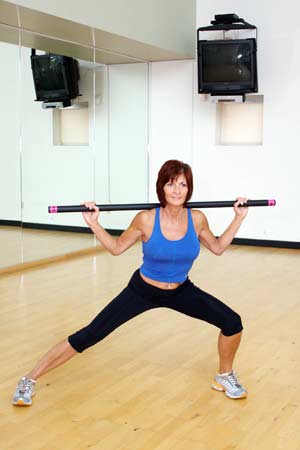|
|
What is functional strength training? Functional strength training has become a popular buzzword in the fitness industry. Unfortunately, it is also subject to wide interpretation. Functional strength training has become a popular buzzword in the fitness industry. Unfortunately, it is also subject to wide interpretation.
At the extreme, some individuals believe that by mimicking the explosive, ballistic activities of high-level competitive athletes, they are training in a functional manner. All too often, however, such training programs greatly exceed the physiological capabilities of the average exerciser, which ultimately increases the possibility that an injury might occur.
Most would agree that there is nothing functional about sustaining an injury due to improper training.
In many respects, functional strength training should be thought of in terms of a movement continuum. As humans, we perform a wide range of movement activities, such as walking, jogging, running, sprinting, jumping, lifting, pushing, pulling, bending, twisting, turning, standing, starting, stopping, climbing and lunging. All of these activities involve smooth, rhythmic motions in the three cardinal planes of movement- sagittal, frontal and transverse.
Training to improve functional strength involves more than simply increasing the force-producing capability of a muscle or group of muscles. Rather, it requires training to enhance the coordinated working relationship between the nervous and muscular systems.
Functional strength training involves performing work against resistance in such a manner that the improvements in strength directly enhance the performance of movements so that an individual's activities of daily living are easier to perform. Simply stated, the primary goal of functional training is to transfer the improvements in strength achieved in one movement to enhancing the performance of another movement by affecting the entire neuromuscular system.
In functional training, it is as critical to train the specific movement as it is to train the muscles involved in the movement. The brain, which controls muscular movement, thinks in terms of whole motions, not individual muscles.
Exercises that isolate joints and muscles are training muscles, not movements, which results in less functional improvement. For example, squats will have a greater "transfer effect" on improving an individual's ability to rise from a sofa than knee extensions.
For strength exercises to effectively transfer to other movements, several components of the training movement need to be similar to the actual performance movement. This includes coordination, types of muscular contractions (concentric, eccentric, isometric), speed of movement and range of motion.
Each individual component of the training movement must be viewed as only a single element of the entire movement. The exercises with the highest transfer effect are those that are essentially similar to the actual movement or activity in all four components. It is important to note, however, that individuals cannot become expert at a particular movement or activity by training only with similar movements. For optimal results, repeated practice of the precise movement is required.
Exercises performed on most traditional machines tend to be on the low-end of the functional-training continuum because they isolate muscles in a stabilized, controlled environment. While it may be true that traditional, machine-based exercises are not the best way to transfer performance from the weight room to the real world, it does not mean that such exercises should not be a part of a training program.
For example, "non-functional," single-joint exercise can play a critical role in helping to strengthen a "weak link" that a person may have to restore proper muscle balance. Furthermore, doing such an exercise can allow an individual to more safely and effectively participate in functional-training activities while also reducing the risk of injury.
In the final analysis, it must be remembered that functional training is not an all-or-nothing concept. A continuum of functionality exists. The only entirely functional exercise is the actual activity one is training for.
Accordingly, individuals shouldn't rely on any single group of exercises. Individuals should use all the weapons in their training arsenal. Functional strength training should serve as a supplement to traditional strength training, not as a replacement.
Properly applied, functional strength training may provide exercise variety and additional training benefits that more directly transfer improvements to real-life activities.
from ace fitness
 该贴已经同步到 601023766的微博 该贴已经同步到 601023766的微博 |
评分
-
查看全部评分
|

 |小黑屋|手机版Mobile|体能论坛
( 粤ICP备15092216号-2 )
|小黑屋|手机版Mobile|体能论坛
( 粤ICP备15092216号-2 )